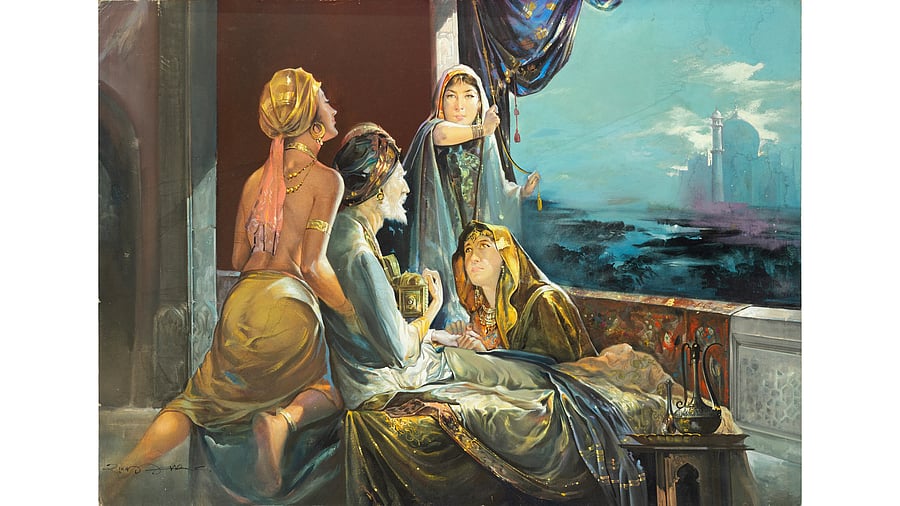
The Last Days of Shahjahan, unidentified artist.
Credit: Special arrangement
A new exhibition in Delhi positions the Taj Mahal as a silent, yet ‘speaking’ agent. Curated by author and historian Rana Safvi, The Mute Eloquence of the Taj Mahal presents a comprehensive visual narrative, comprising 200 remarkable works, including Company School paintings, works by Agra-based artists, visiting foreign and modern Indian artists, plans, correspondence, essays, official reports as well as photographs and postcards by renowned foreign and Indian photographers from the late 18th to the mid-20th century. “When we speak of the Taj Mahal, we begin with the familiar tale of love and loss — Shah Jahan, Mumtaz Mahal and the white marble tomb that became the world’s emblem of eternal love. Yet beyond this legend, beyond its marble, poetry and myth, lie a deeper truth. The Taj Mahal is not only a memorial of devotion but an architectural meditation on mortality, resurrection and divine harmony, rooted in Islamic theology and Mughal artistry,” explained Safvi.
As a student, she once saw it as Tagore did, “a teardrop on the cheek of time”, a monument born of imperial grandeur and personal grief. But through her study of Islamic architecture and Sufi thought, it revealed itself as something more — not merely a mausoleum, but a bridge between the temporal and the eternal.
“Shah Jahan, an ordained Sufi, imbued the Rauza-e-Munawwara (Illuminated Tomb) with sacred meaning. Its calligraphy, geometry and reflecting pool mirror Quranic visions of paradise, judgement and divine unity. The Taj is thus not only a monument of love, but also a cosmic allegory of transcendence,” elaborated Safvi.
Hence, in her second collaboration with DAG on this exhibition, she explores the ways in which the tomb’s design and details speak of the beliefs and aspirations of Shah Jahan and his beloved wife Mumtaz Mahal through selected quotations from the Quran and the language of flowers.
The sacred and the quotidian
The exhibition is divided into two parts — the sacred and the quotidian. Company paintings by Agra-based artists offer exquisitely detailed visual records of the monument’s intricate pietra dura inlay work, serving as invaluable documentary evidence that preserves the monument’s ornamental details with exceptional precision and artistry.
A selection of works by visiting foreign artists, ranging from the late 18th-century views of British artist Thomas Daniell to the elegant 1930s woodblock prints of Japanese master Hiroshi Yoshida and British artist Charles William Bartlett, collectively trace the evolving global fascination with the Taj Mahal, revealing how it has been variously interpreted, romanticised and reimagined across artistic traditions. In addition, works by modern Indian artists, including Abanindranath Tagore, L N Taskar, S Bagchi and Jyoti Bhatt, offer powerful interpretations of the monument, reflecting not only its enduring beauty but also its layered historical meanings and cultural significance in the context of an emerging Indian modernity.
Further, a compelling collection of photographs and postcards dating from the 1850s to the mid-20th century, charts not only the evolution of photographic techniques but also the Taj Mahal’s enduring role in shaping visual narratives of India, through the work of a diverse group of acclaimed photographers — from European war and commercial pioneers, such as Felice Beato, Samuel Bourne, John Edward Saché and Thomas Rust to renowned Indian photographers like Lala Deen Dayal and R R Bharadwaj. For the first time, selections from the archive of Albert Edward Griessen, Superintendent of the Taj and Government Gardens (1902–1905), are also on public view.
Research for the catalogue and the exhibition has been immense, and took Safvi two years to curate, select and put together. The exhibition and the book explore some less-explored aspects of the tomb and its complex, such as the Taj’s role in the commercial life of the city through the almost forgotten market sector known as Taj Ganj and the role of other women besides Mumtaz Mahal in the court of Shah Jahan.
The Mute Eloquence of the Taj Mahal will remain on view until December 6 at DAG, New Delhi.